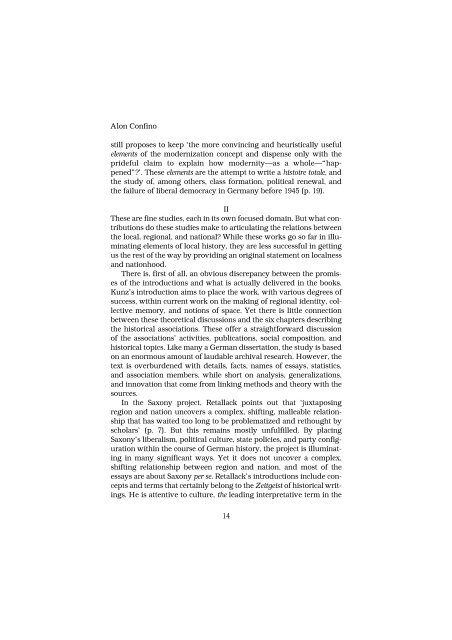Download - German Historical Institute London
Download - German Historical Institute London
Download - German Historical Institute London
Create successful ePaper yourself
Turn your PDF publications into a flip-book with our unique Google optimized e-Paper software.
Alon Confino<br />
still proposes to keep ‘the more convincing and heuristically useful<br />
elements of the modernization concept and dispense only with the<br />
prideful claim to explain how modernity—as a whole—“happened”?’.<br />
These elements are the attempt to write a histoire totale, and<br />
the study of, among others, class formation, political renewal, and<br />
the failure of liberal democracy in <strong>German</strong>y before 1945 (p. 19).<br />
II<br />
These are fine studies, each in its own focused domain. But what contributions<br />
do these studies make to articulating the relations between<br />
the local, regional, and national? While these works go so far in illuminating<br />
elements of local history, they are less successful in getting<br />
us the rest of the way by providing an original statement on localness<br />
and nationhood.<br />
There is, first of all, an obvious discrepancy between the promises<br />
of the introductions and what is actually delivered in the books.<br />
Kunz’s introduction aims to place the work, with various degrees of<br />
success, within current work on the making of regional identity, collective<br />
memory, and notions of space. Yet there is little connection<br />
between these theoretical discussions and the six chapters describing<br />
the historical associations. These offer a straightforward discussion<br />
of the associations’ activities, publications, social composition, and<br />
historical topics. Like many a <strong>German</strong> dissertation, the study is based<br />
on an enormous amount of laudable archival research. However, the<br />
text is overburdened with details, facts, names of essays, statistics,<br />
and association members, while short on analysis, generalizations,<br />
and innovation that come from linking methods and theory with the<br />
sources.<br />
In the Saxony project, Retallack points out that ‘juxtaposing<br />
region and nation uncovers a complex, shifting, malleable relationship<br />
that has waited too long to be problematized and rethought by<br />
scholars’ (p. 7). But this remains mostly unfulfilled. By placing<br />
Saxony’s liberalism, political culture, state policies, and party configuration<br />
within the course of <strong>German</strong> history, the project is illuminating<br />
in many significant ways. Yet it does not uncover a complex,<br />
shifting relationship between region and nation, and most of the<br />
essays are about Saxony per se. Retallack’s introductions include concepts<br />
and terms that certainly belong to the Zeitgeist of historical writings.<br />
He is attentive to culture, the leading interpretative term in the<br />
14













